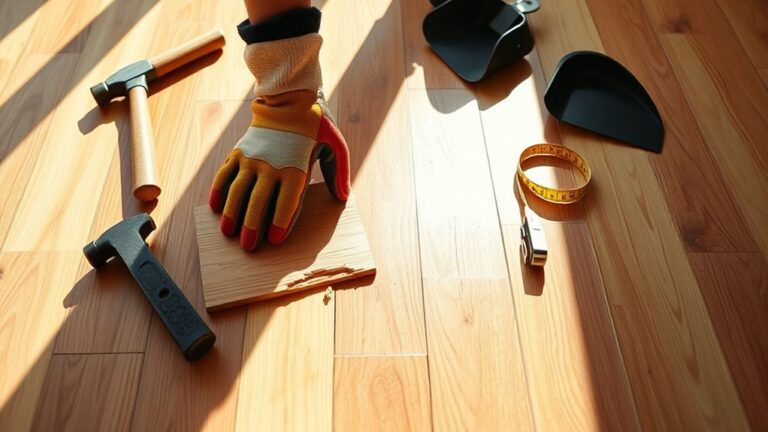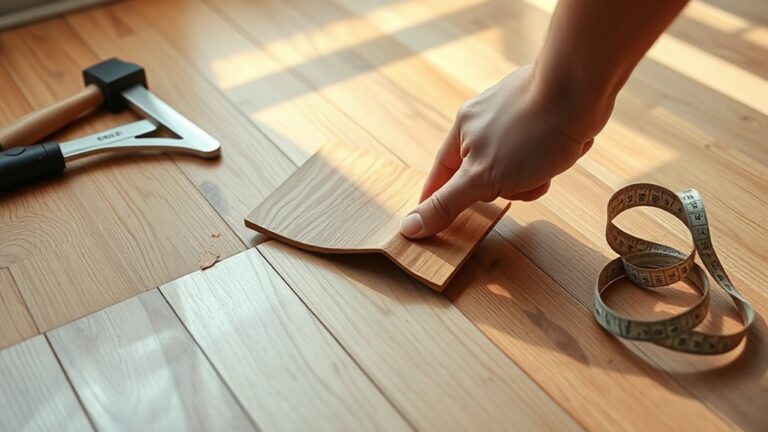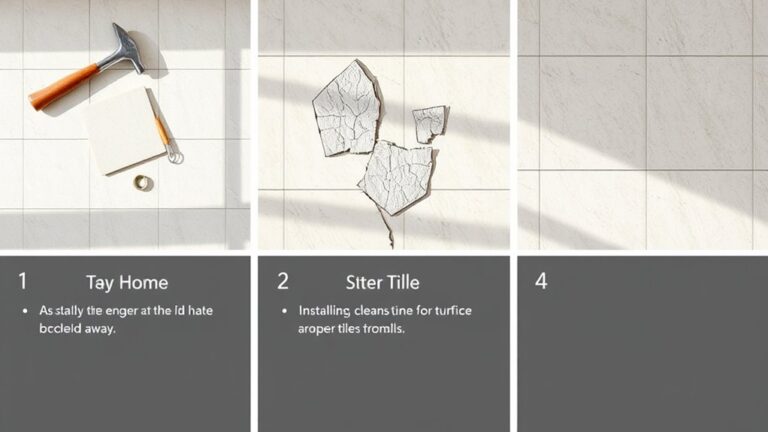Dealing with stains on marble floors requires a strategic approach. First, identify the stain type—organic, oil-based, or inorganic. For oil-based stains, mix baking soda and water to create a paste; apply it and let it sit overnight. Organic stains respond well to a hydrogen peroxide and baking soda poultice. Always act quickly to clean spills, as marble is porous. Regularly sealing your marble every 6-12 months prevents stains and moisture damage. For persistent stains, consider professional assessment and treatment for ideal results. There's much more you can assess for improving your marble maintenance.
Understanding Marble Stains
When it comes to understanding marble stains, it's important to recognize that they can be classified into three main categories: organic, oil-based, and inorganic. Each type of stain requires different cleaning approaches for effective removal. Organic stains are typically caused by food and beverages, such as coffee, wine, or fruit juices. These stains can penetrate the marble's porous surface, making immediate spill cleanup vital to prevent long-lasting discoloration.
Oil-based stains, on the other hand, usually come from substances like cooking oils, cosmetics, or even greasy foods. These stains can be particularly stubborn, as they tend to bond with the marble's surface. The right cleaning approach often includes using a specialized poultice designed to draw out the oil from the stone effectively.
Inorganic stains, such as rust or ink, present unique challenges due to their chemical composition. These stains may require specialized treatments that target their specific properties, making professional assistance a viable option if DIY methods fail.
Regular maintenance is essential in preserving the aesthetic appeal and integrity of your marble floors. This includes routine sealing to create a protective barrier against stains and prompt addressing of any spills. Keeping a watchful eye on your marble surfaces will guarantee that you maintain their beauty while minimizing the risk of severe staining. By understanding the types of marble stains and employing appropriate cleaning strategies, you can protect your investment and enjoy the elegance of marble for years to come.
Common Types of Stains
Identifying common types of stains on marble floors is essential for effective maintenance and cleaning. Understanding these stains enables you to take the right steps to preserve the beauty of your marble. Here's a breakdown of the most common types of stains you may encounter:
| Stain Type | Description | Sources |
|---|---|---|
| Oil-Based Stains | Light brown or yellowish stains from cooking oils, grease, or cosmetics. | Cooking, personal care products |
| Organic Stains | Light to dark brown stains caused by coffee, tea, or fruit juices. | Kitchen spills, dining areas |
| Rust Stains | Copper-colored or brown marks from metal items left on the surface. | Furniture, tools |
Oil-based stains are particularly challenging to remove due to their ability to penetrate the porous marble surface. Meanwhile, organic stains are frequent issues, especially in kitchens and dining areas. Rust stains, often appearing as unsightly marks, can be difficult to eliminate without specialized treatments. Water stains, typically manifested as white, cloudy marks, result from moisture and hard water buildup. Finally, ink stains may arise from pens or wine spills and can be either water or alcohol-based, requiring specific treatments to effectively remove stains from marble.
Being aware of these common stains will help you maintain your marble floors, ensuring they continue to shine beautifully for years to come.
Techniques for Stain Removal
Removing stains from marble floors can seem challenging, but with the right techniques, you can effectively restore their pristine appearance. To tackle oil-based stains, mix baking soda with water to form a paste. Apply this paste directly to the stain, cover it with plastic wrap, and let it sit overnight. Afterward, rinse the area thoroughly.
For organic stains, such as coffee or wine, a poultice made from hydrogen peroxide and baking soda works well. Apply the poultice to the stain, cover it, and allow it to sit for 24 hours. This method will absorb the discoloration, helping to remove the stain effectively.
Rust stains require a different approach. You can use a non-acidic rust remover or create another poultice, but if the stain has set in, seeking professional help is often your best option for effective removal.
Water stains are usually more straightforward to manage. A good marble cleaner can handle minor cases, but for tougher stains, gently buff the area with Grade 0000 steel wool.
Before applying any stain removal method, it's essential to test it on an inconspicuous section of your marble surfaces. This step guarantees there's no adverse reaction, preserving the integrity of your marble while effectively removing stains. With these techniques, you can maintain the beauty of your marble floors and enjoy their elegance without worry.
Preventive Care for Marble
To maintain the integrity of your marble floors, immediate cleanup of spills is essential, especially for acidic substances that can cause etching. Regularly sealing your marble every 6-12 months also plays an important role in protecting against stains and moisture. By implementing these preventive measures, you can greatly extend the life and appearance of your marble surfaces.
Immediate Spill Cleanup
Cleaning up spills immediately is essential for maintaining the integrity of marble floors, given their porous nature that allows liquids to seep in and cause lasting stains. When a spill occurs, you should blot the area with a damp cloth rather than wiping it, as this can spread the liquid and worsen the staining. The immediate cleanup of spills is particularly vital for acidic substances like fruit juices or vinegar, which can corrode the marble surface and lead to etching.
To effectively protect your marble floors, consider placing coasters under drinks and mats beneath food items. These simple precautions can greatly reduce the likelihood of spills and help maintain the pristine condition of your porous stone. If a spill does happen, act swiftly to clean the surface, preventing any potential staining.
Regular Sealing Schedule
A regular sealing schedule is essential for preserving the beauty and durability of marble floors. By implementing a systematic approach to sealing, you can effectively protect your marble from stains and moisture. Here are key points to keep in mind:
- Frequency: Seal your marble floors every 6 to 12 months, especially in high-traffic areas where wear and tear is more pronounced.
- Water Absorption Check: Observe how water interacts with the surface. If it absorbs rather than beads, it's time for re-sealing.
- Use High-Quality Sealers: Opt for high-quality impregnating sealers that provide superior protection and can extend sealing intervals in low-traffic areas.
- Post-Cleaning Application: Always apply a sealer after professional cleaning to restore the protective barrier that prevents stains and preserves the integrity of marble countertops.
Professional Restoration Options
When it comes to addressing deep-set stains in your marble floors, professional restoration options provide the expertise needed for effective stain removal. These specialists use advanced techniques, such as specialized poultices and polishing methods, to tailor their approach based on the specific type of stain. By choosing professional services, you guarantee that your marble is restored to its original luster while minimizing the risk of damage.
Expertise in Stain Removal
The expertise of professional restoration services can make a significant difference in addressing tough stains on marble floors. When you're faced with stubborn stains, consulting experts guarantees a tailored approach that considers both the stain type and the marble's condition. Here are some key benefits of professional care:
- Comprehensive Assessment: Professionals evaluate the stain and marble's condition to develop an effective treatment plan.
- Advanced Techniques: They often use marble poultice methods and non-acidic cleaning agents, preserving the marble's integrity while effectively removing stains.
- Access to Technology: Expert restoration services utilize the latest stain removal technologies, guaranteeing the best possible results.
- Post-Cleaning Sealing: After stain removal, professionals often apply a sealant, which helps protect against future staining and enhances the marble's appearance.
Advanced Restoration Techniques
Professional restoration services not only excel in stain removal but also employ advanced restoration techniques to rejuvenate marble floors. These techniques, such as diamond polishing, effectively restore the shine and luster of dull or stained marble. Specialized stain removers and poultices are utilized by experts to tackle deep-set stains that DIY methods often fail to eliminate.
Experienced technicians assess the specific type of stain to determine the best treatment, whether it involves chemical solutions, mechanical polishing, or a combination of both. Here's a quick overview of these advanced options:
| Technique | Benefits |
|---|---|
| Diamond Polishing | Restores shine and luster |
| Specialized Stain Removers | Targets deep-set stains without damage |
| Mechanical Polishing | Provides a smooth, reflective finish |
| Sealing | Offers long-lasting protection against future stains |
| Regular Maintenance | Extends the life of marble and reduces restoration needs |
After successful stain removal, professionals typically seal the marble, enhancing its durability and appearance. With regular maintenance and professional care, you can notably prolong the life of your marble flooring.
Essential Cleaning Products
Cleaning marble floors requires specific products that guarantee both effectiveness and safety. To maintain the elegance of your marble while effectively addressing stains, it's vital to utilize the right cleaning supplies. Here's a list of necessary products you'll need:
- Mild Dish Soap: Using a gentle dish soap helps to clean surfaces without damaging the marble's finish. It effectively cuts through grime and dirt without leaving harmful residues behind.
- Spray Bottle: A spray bottle is important for mixing and applying your cleaning solutions evenly across the stained area. This allows for precise application, especially in hard-to-reach spots.
- Microfiber Cloth: Opt for microfiber cloths when wiping down your marble floors. They're soft and non-abrasive, preventing scratches while ensuring your surfaces remain clean and polished.
- 12% Hydrogen Peroxide: For stubborn stains that resist conventional cleaning methods, a solution of 12% hydrogen peroxide can be quite effective. When used carefully, it can treat tough stains without compromising the integrity of the marble.
Tips for Long-lasting Maintenance
Maintaining the beauty of marble floors goes beyond just using the right cleaning products. To guarantee the longevity and durability of your marble, follow these essential tips for long-lasting maintenance:
| Tip | Description | Frequency |
|---|---|---|
| Regularly seal marble | Apply a high-quality sealant every 6-12 months to protect against stains and moisture. | Every 6-12 months |
| Clean spills immediately | Use a soft cloth to blot spills right away, preventing acidic substances from etching the surface. | As needed |
| Use a gentle cleaning solution | Mix mild dish soap with warm water to clean, avoiding harsh chemicals that can damage marble. | Weekly |
| Employ coasters and mats | Place coasters under drinks and mats in high-traffic areas to minimize direct contact and thermal shock. | Always |
Incorporating these practices into your routine maintenance will help in maintaining the floor's shine and aesthetic appeal. Remember, it's vital to perform regular dusting and sweeping to remove dirt and debris, as neglecting this can lead to scratches and dullness over time.
For removing stubborn stains, consider using specialized marble stain removers or consult a professional if the stains persist. By taking these proactive steps, not only do you enhance the beauty of your marble floors, but you also extend their lifespan considerably. With consistent care and attention, you can enjoy the elegance of marble in your space for years to come.
Frequently Asked Questions
How to Get a Stain Out of a Marble Floor?
You're looking at that stain, wondering how to get it out. First, identify the stain type—common marble stains can be tricky. For effective stain removal techniques, consider natural stain removers like baking soda or hydrogen peroxide. Apply your chosen poultice, let it sit, then rinse. Don't forget marble care tips: seal regularly and use proper marble polishing methods. If it's stubborn, professional restoration services might be your best bet for a flawless finish.
Can Stains on Marble Be Buffed Out?
Yes, stains on marble can sometimes be buffed out using effective buffing techniques. For minor staining causes, you might try polishing products or DIY solutions like fine-grade steel wool. Regular marble care includes maintenance tips such as applying protective sealants. However, for deeper stains, consider professional services to avoid further damage. Always test your chosen method on an inconspicuous area first to guarantee you're not scratching the surface during the buffing process.
Are Marble Stains Permanent?
Are marble stains permanent? Not necessarily. With proper marble care, you can often restore that elegant shine. Implementing stain prevention techniques, like using sealants, can help guard against surface damage. When stains appear, utilize effective cleaning tips and polishing techniques to tackle them promptly. For stubborn issues, don't hesitate to consult professional restoration services. Keeping a regular maintenance schedule guarantees your marble remains pristine, allowing you to enjoy its beauty without worry.
Can You Fix Discolored Marble?
Yes, you can fix discolored marble. Start with DIY marble solutions like a baking soda poultice for common marble stains. For better results, consider marble restoration techniques and professional marble services if stains persist. Implement marble cleaning tips and stain prevention methods, like regular sealing, to protect your marble surface. Using quality marble care products guarantees longevity, while effective marble surface protection keeps your stone looking pristine and vibrant.




